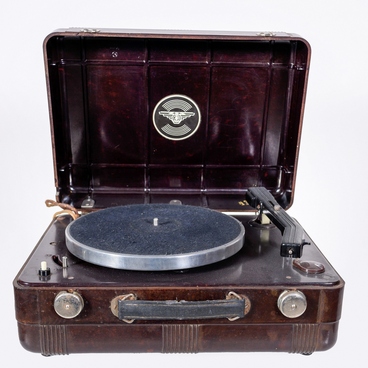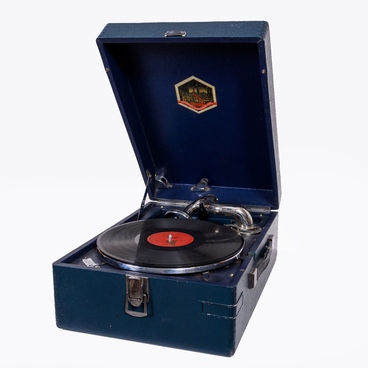The portable pathephone called “Malyutka” was produced at the Moscow Pathephone Factory either in the 1930s or 1940s — the exact date of its manufacture is unknown. The case of the portable gramophone is metal and has a carrying handle on top of it. The left side features a slot where the handle for winding the spring was inserted. The pathephone weighed about two kilograms, its size being only 13×29 centimeters. Despite having such modest dimensions, it could play records of any diameter.
The first pathephones were made in pre-revolutionary Russia. They were different from gramophones because they did not have a large outer horn. The French company “Pathe” (from which the name pathephone was derived) supplied the devices to the Russian Empire. Such players were called portable gramophones abroad.
In Soviet times, portable pathephones were produced at several factories in different cities: Moscow, Leningrad, Kolomna, Vladimir, and Dnepropetrovsk. During the Great Patriotic War, they were used for propaganda: soldiers listened to records of Joseph Stalin’s speeches or popular patriotic songs. At that time, the pathephones were called trench gramophones, but after the war, they got another, more “peaceful” name — the beach ones. Soviet youth often fetched the pathephone to the countryside or danced to it right in the city courtyards.
Mechanical pathephones had a spring-actuated drive for turning the record which was started by a special knob. This had to be done very carefully: if the spring broke from sudden movements or excessive tension, it would be very difficult to buy and replace it. A single wind-up was usually enough for three to five minutes — that is about how long the record lasted on one side of the record. Models that enabled both sides of the record to be used after just one wind-up were rare.
The pathephone soundbox consisted of a needle, which read the magnetic track on the record, and a diaphragm amplifier. The first pathephone needles were steel, and they blunted after each use, and so had to be often changed. Otherwise, the sound got worse, and the blunt tip could ruin the record itself. They were gradually replaced by more durable sapphire needles.
The first pathephones were made in pre-revolutionary Russia. They were different from gramophones because they did not have a large outer horn. The French company “Pathe” (from which the name pathephone was derived) supplied the devices to the Russian Empire. Such players were called portable gramophones abroad.
In Soviet times, portable pathephones were produced at several factories in different cities: Moscow, Leningrad, Kolomna, Vladimir, and Dnepropetrovsk. During the Great Patriotic War, they were used for propaganda: soldiers listened to records of Joseph Stalin’s speeches or popular patriotic songs. At that time, the pathephones were called trench gramophones, but after the war, they got another, more “peaceful” name — the beach ones. Soviet youth often fetched the pathephone to the countryside or danced to it right in the city courtyards.
Mechanical pathephones had a spring-actuated drive for turning the record which was started by a special knob. This had to be done very carefully: if the spring broke from sudden movements or excessive tension, it would be very difficult to buy and replace it. A single wind-up was usually enough for three to five minutes — that is about how long the record lasted on one side of the record. Models that enabled both sides of the record to be used after just one wind-up were rare.
The pathephone soundbox consisted of a needle, which read the magnetic track on the record, and a diaphragm amplifier. The first pathephone needles were steel, and they blunted after each use, and so had to be often changed. Otherwise, the sound got worse, and the blunt tip could ruin the record itself. They were gradually replaced by more durable sapphire needles.



